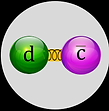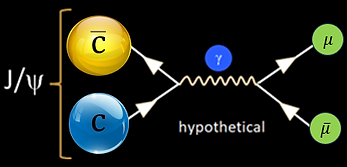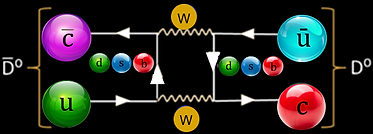Anticharm Quark
Composition :
Statistics : Generation :
Family :
Interaction forces :
Symbol :
Antiparticle :
Mass :
Decays into :
Electric charge :
Color charge
Spin :
Weak isospin :
Elementary antiparticle
Fermionic
Second
Quark
strong, weak,
electromagnetic force
gravity
c
Charm quark ( c )
2.2 MeV/c²
strange quark (~95%)
down quark (~5%)
-²∕₃ e
Yes
¹/₂
LH = +¹/₂; RH = 0
+ 0,5
- 0,4
_



Dit is een paragraaf. Klik hier om je eigen tekst toe te voegen.
ANTICHARM QUARK
General
An anticharm quark, often denoted as c- , is the antiparticle counterpart of the charm quark (c) in the Standard Model of particle physics. Like all quarks, the anticharm quark is a fundamental particle that plays a critical role in our understanding of the strong and weak nuclear forces.
Characteristics of the Anticharm Quark:
Electric Charge: The anticharm quark has an electric charge of -2/3e, where "e" represents the elementary charge. This negative charge makes it one of the negatively charged quarks, along with the down quark (d) and the strange quark (s).
Mass: The anticharm quark has a mass similar to that of the charm quark, with a mass of approximately 1.27 GeV/c² (gigaelectronvolts divided by the speed of light squared).
Spin: The anticharm quark has a half-integer spin of 1/2, a fundamental property shared by all quarks, which is associated with their intrinsic angular momentum.
Color Charge: Like all quarks, the anticharm quark carries a "color charge," a property associated with the strong nuclear force (quantum chromodynamics or QCD). Quarks come in three "colors" (red, green, and blue) and can combine in ways that result in color-neutral hadrons.
Context in Quantum Physics and Quantum Field Theory:
Strong Nuclear Force (Quantum Chromodynamics, QCD): The behavior of anticharm quarks, like all quarks, is governed by the strong nuclear force described by QCD. This force is mediated by particles called gluons, which carry the color charge. QCD is a crucial component of the Standard Model and governs the behavior of quarks and gluons within hadrons, such as mesons (quark-antiquark pairs) and baryons (three-quark combinations).
Weak Interaction: Anticharm quarks, like other quarks, can participate in weak interactions, which are responsible for processes such as quark flavor-changing decays. Weak interactions involve the exchange of W and Z bosons and are described by electroweak theory, a component of the Standard Model.
Quantum Field Theory (QFT): The behavior of anticharm quarks, as well as other quarks, is described within the framework of quantum field theory (QFT). In QFT, particles are viewed as excitations of underlying quantum fields. Quarks are the excitations of quark fields, and their interactions with one another and with gluons are described mathematically using field equations.
The anticharm quark is of particular interest in particle physics because it, along with the charm quark, plays a role in certain types of decays and reactions that allow physicists to test the predictions of the Standard Model and explore the dynamics of the strong and weak nuclear forces. Studies involving anticharm quarks are conducted at particle colliders like the Large Hadron Collider (LHC) to gain insights into the fundamental forces and particles that make up the universe.
Combinations with Anticharm Quarks
Mesons:
Charmonium Mesons: These are mesons consisting of an anticharm quark (c ̅ ) and a charm quark (c).
Anticharmed Mesons: Anticharm quarks can combine with other quarks to form anticharmed mesons. The charm quark and the anticharm quark carry opposite electric charges.
D⁻ meson
D° meson
Ds⁻ meson
Baryons:
Anticharmed Baryons: These are baryons consisting of at least one anticharm quark (cˉ). Anticharmed baryons are relatively rare compared to charmed baryons.
Λˉc baryon
Ξˉc° baryon
Ωˉc baryon (very rare)

Figure 105 - J/ψ meson (charmonium state)

Figure 106 - D− meson

Figure 107 - D0 meson

Figure 108 - Ds− meson

Figure 109 - Λˉc baryon

Figure 111 - Ωˉc baryon (very rare)

Figure 110 - Ξˉc0 baryon
Creation of Anti-Charmquarks
Quark-Gluon Plasma (QGP) Era (Moments After the Big Bang): In the first fractions of a second after the Big Bang, the universe was extremely hot and dense. During this phase, the universe existed in a state called the Quark-Gluon Plasma (QGP), where quarks and gluons were not confined within hadrons but were free particles. During this time, anticharm quarks (cˉ) and charm quarks (c) were created abundantly. As the universe cooled and expanded, quarks and gluons combined to form hadrons.
Hadronization: As the universe continued to cool and expand, the QGP underwent a phase transition called hadronization. During this process, quarks combined with their corresponding antiquarks to form mesons and baryons, including those containing anticharm quarks. For example, cˉc pairs could form charmonium mesons like the J/ψ meson.
Big Bang Nucleosynthesis: A few minutes after the Big Bang, as the universe further cooled, the process of Big Bang nucleosynthesis occurred. During this phase, protons and neutrons formed from quarks and combined to create light atomic nuclei. Anticharm quarks, as well as charm quarks, played a role in the formation of these protons and neutrons.
Particle Collisions and Cosmic Rays: Throughout the history of the universe, anticharm quarks have been created in high-energy particle collisions and cosmic ray interactions. Natural cosmic rays, which consist of various particles, including protons and heavier nuclei, can collide with atoms in the Earth's atmosphere or cosmic dust, producing secondary particles, including anticharm quarks.
Particle Colliders: In modern times, particle accelerators and colliders, such as the Large Hadron Collider (LHC), have been used to create and study anticharm quarks in controlled experiments. These machines accelerate particles to extremely high energies and collide them, leading to the creation of short-lived particles, including those containing charm and anticharm quarks.
Rare Decays: In certain particle decays, anticharm quarks can be produced as intermediate particles. For example, in processes involving the weak interaction, c or cˉ quarks can change into each other during rare decays.

Figure 112 - Creation of charm antiquark
Decay of Anticharm Quarks
Anticharm quarks (cˉ) can be involved in various decay processes, both as initial or intermediate particles. These processes are part of the study of particle physics and are governed by the fundamental forces described by the Standard Model. Here are some of the known decay processes where anticharm quarks are involved:
Charmonium Meson Decays: Charmonium mesons, which consist of a charm quark (c) and an anticharm quark (cˉ), can decay into lighter particles. For example, the J/ψ meson (ccˉ) can decay into muon-antimuon pairs (μ+μ−) via the electromagnetic interaction.
Semileptonic Decays: Anticharm quarks can participate in semileptonic decays, where a heavy quark transitions to a lighter quark through the exchange of a W or Z boson. These decays often involve the conversion of a charm quark into an antistrange quark. For example, a D0 meson (c⁻u) can decay into a K+ meson (us⁻) and a π- meson.
Charm Baryon Decays: Anticharm quarks can be part of charm baryons, and these baryons can undergo various decay processes. For instance, a Λc+ baryon (cdu) can decay into a p (proton) and a K− meson (suˉ).
Rare Decays: Some rare decay processes involve the transformation of a charm quark into an anticharm quark or vice versa. These processes are governed by the weak interaction and are typically characterized by low branching fractions. An example is the rare decay Dˉ0→D0, where a charm antimeson (D-0) transforms into a charm meson (D0).
Exotic States: In some cases, anticharm quarks are involved in the decays of exotic states or resonances that are not part of the standard meson or baryon spectrum. These decays can provide insights into the behavior of heavy quarks and their interactions.
Heavy Quarkonia Decays: Heavy quarkonia states, which include charmonium (ccˉ) and bottomonium (bbˉ) states, can decay through various processes, including radiative decays where photons are emitted.

Figure 113 - J/ψ meson decay

Figure 114 - D0 meson decay

Figure 115 - D0→Dˉ0 decay
Annihilation
The annihilation of a charm quark with its corresponding charm antiquark, like any quark-antiquark annihilation, results in the conversion of their energy into other particles. The specific outcome can vary depending on the energy available and the details of the interaction. Here are a few points specific to charm quark-antiquark annihilation:
Flavor Conservation:
The total flavor (charm) is conserved in the annihilation process. This means that the final-state particles must include the same total charm as the initial-state particles.
Creation of Quark-Antiquark Pairs:
The primary outcome of the annihilation is the creation of new quark-antiquark pairs. These pairs can involve not only charm quarks and antiquarks but also other flavors of quarks, depending on the available energy.
Gluon Emission:
During the annihilation process, a gluon is often exchanged. Gluons mediate the strong force that binds quarks together. The gluon can subsequently split into a quark-antiquark pair, contributing to the overall particle production.
Diversity of Final States:
The final-state particles can include a variety of quark-antiquark pairs and gluons, leading to a diverse set of possible outcomes. The specific particles produced depend on the energy scale of the annihilation process.


















